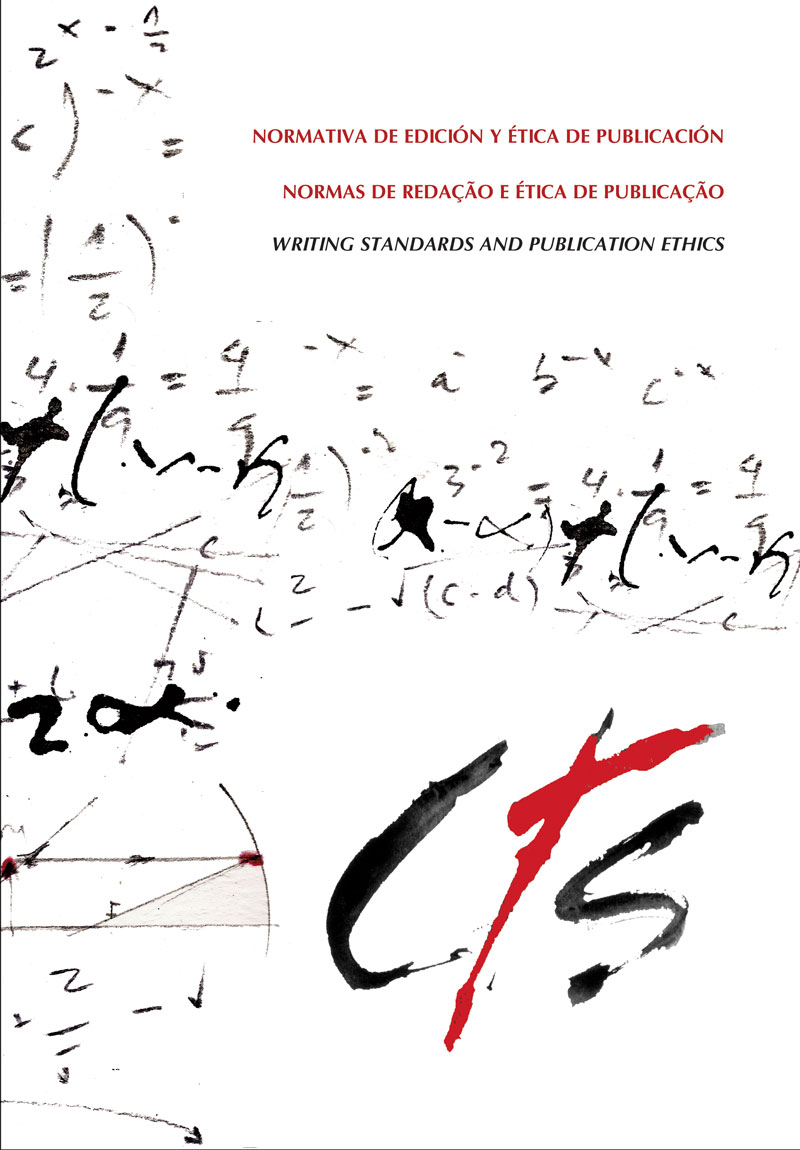Technoscientific Futures: New Challenges in Solar Geoengineering
Keywords:
techno-science, Anthropocene, geoengineering, climate change, Great AccelerationAbstract
The emergence and proliferation of techno-sciences since the mid-20th century has rapidly accelerated the transformation of natural spheres. The technosphere is a new interconnected system that has superimposed itself upon the biosphere. It consists of multiple artificial objects and their various interrelationships, accounting for a considerable amount of the environmental risks of our time. This article explores its expansion during the Great Acceleration of the 20th century from two practices within techno-scientific activity: the use of computer simulations and meteorological intervention. Both of them currently converge in the recent proposals for solar radiation management (SRM), which aims to transform and regulate atmospheric conditions in order to reduce global warming. The current climate crisis and the advancements in geoengineering suggest that there are certain elements that may give rise to the appearance of future climate techno-sciences, based on private initiatives and research platforms such as Future Earth. The prediction and prevalence of underlying risks are matters to be anticipated by STS studies. Together, they form an agenda of issues centered on the Technocene: the era of techno-sciences as the main altering force of the Earth System.Downloads
References
Arias Maldonado, M. (2018). Antropoceno. La política en la era humana. Madrid: Taurus.
Asayama, S., Sugiyama, M., Ishii, A. y Kosugi, T. (2019). Beyond solucionist science for the Anthropocene: To navigate the contentious atmosphere of solar geoengineering. The Anthropocene Review, 6(1-2), 19-37.
Baskin, J. (2019). Geoengineering, the Anthropocene and the End of Nature. Cham: Palgrave Macmillan.
Beck, S. (2019). Coproducing Knowledge and Politics of the Anthropocene: The Case of the Future Earth Program. En F. Biermann y E. Lövbrand (Eds.), The Practices of Political Study in the Anthropocene (191-211). Cambridge: Cambridge University Press.
Bonnheim, N. B. (2010). History of climate engineering. WIREs Climate Change, 1(6), 891-897.
Boulton, G. (2018). The challenges of a Big Data Earth. Big Earth Data, 2(1), 1-7.
Byers, H. R. (1974). History of weather modification. En W. N. Hess (Ed.), Weather and climate modification (3-44). Nueva York: Wiley.
C2G2 (2019). Geoingeniería: la necesidad de gobernanza. Nueva York: Iniciativa Carnegie para la Gobernanza de la Geoingeniería Climática.
Cearreta, A. (2015). La definición geológica del Antropoceno según el Anthropocene Working Group (AWG). Enseñanza de las Ciencias de la Tierra, 23(3), 263-271.
Cera, A. (2017). The Technocene or Technology as (Neo)Environment. Techné: Research in Philosophy and Technology, 21(2-3), 243-282.
Cózar Escalante, J. M. (2019a). Ingenieros del Antropoceno digital: la enseñanza de las ingenierías en una época incierta. Revista Iberoamericana de Ciencia, Tecnología y Sociedad —CTS, 14(41), 185-196.
Cózar Escalante, J. M. (2019b). El Antropoceno. Tecnología, naturaleza y condición humana. Madrid: Los Libros de la Catarata.
Cressey, D. (2012). Cancelled project spurs debate over geoengineering patents – SPICE research consortium decides not to field-test its technology to reflect the Sun’s rays. Nature. 485(7399), 429.
Crutzen, P. J. y Stoermer, E. F. (2000). The ‘Anthropocene’. Global Change Newsletter, 41, 17-18.
Crutzen, P. (2006). Albedo enhancement by stratospheric sulfur injections: A contribution to resolve a policy dilemma? Climatic Change, 77, 211-219.
Dannenberg A. y Zitzelsberger, S. (2019). Climate experts’ views on geoengineering depend on their beliefs about climate change impacts. Nature Climate Change, 9, 769–775.
Doel, R. (2003). Constituting the postwar earth sciences: The military’s influence on the environmental sciences in the USA after 1945. Social Studies of Science, 33(5), 635-666.
Echeverría, J. (1999). Los señores del aire: Telépolis y el Tercer Entorno. Barcelona: Destino.
Echeverría, J. (2003). La revolución tecnocientífica. Madrid: Fondo de Cultura Económica.
Echeverría, J. (2009a). Interdisciplinaridad y convergencia tecnocientífica nano-bio-info-cogno. Sociologías, 22, 22-53.
Echeverría, J. (2009b). Los riesgos de la globalización. En J.L. Luján y J. Echeverría (Eds.), Gobernar los riesgos: ciencia y valores en la sociedad del riesgo (187-206). Madrid: Editorial Biblioteca Nueva.
Echeverría, J. (2015). De la filosofía de la ciencia a la filosofía de las tecno-ciencias e innovaciones. Revista iberoamericana de Ciencia, Tecnología y Sociedad —CTS, 10(28), 109-119.
Ellis, E. C. (2015). Ecology in an anthropogenic biosphere. Ecological Monographs, 85(3), 287–331.
Feichter, J. y Quante, M. (2017). From predictive to instructive: Using models for geoengineering. En M. Heymann, G. Gramelsberger y M. Mahony (Eds.), Cultures of Prediction in Atmospheric and Climate Science. Epistemic and Cultural Shifts in Computer-based Modelling and Simulation (178-194). Nueva York: Routledge.
Fleming, J. R. (2010). Fixing the sky: The checkered history of weather and climate control. Nueva York: Columbia University Press.
Fleming, J. R. (2004). Fixing the climate: Military and civilian schemes for cloud seeding and climate engineering. En L. Rosner (Ed.), The technological fix: How people use technology to create and solve problems (X–XX). Londres: Taylor & Francis.
Fleming, J. R. (2007). The Climate Engineers. Wilson Quarterly, 31, 46-60.
Forman, P. y Sánchez-Ron, J. M. (Ed.) (1996). National Military Establishments and the Advancement of Science and Technology: Studies in Twentieth-Century History. Dordrecht: Kluwer Academic Publishers.
Future Earth (2014). Strategic Research Agenda. París: International Council for Science.
Galle, N. J., Notoslawski, S.A. y Pilla, F. (2019). The Internet of Nature: How taking nature online can shape urban ecosystems. The Anthropocene Review, 6(3), 279-287.
Gärdebo, J., Marzecova, A. y Knowles, G. (2017). The orbital technosphere: The provision of meaning and matter by satellites. The Anthropocene Review, 4(1), 44-52.
Greenpeace (2017). Clicking Clean 2017: ¿Quién está ganando la carrera para construir un internet verde? Recuperado de: www.greenpeace.es.
Haff, P. K. (2013). Technology as a geological phenomenon: implications for human well-being. En C. N. Waters, Zalasiewicz J, M. Williams et al. (Eds.), A stratigraphical basis for the Anthropocene. The Geological Society of London (301-309). Londres: Special Publications.
Harper, K. C. (2017). Make it Rain: State Control of the Atmosphere in Twentieth Century America. Chicago: University of Chicago Press.
Harper, K. C. (2008). Climate control: United States weather modification in the cold war and beyond. Endeavour, 32(1), 20–26.
Heymann, M. y Achermann, D. (2018). From Climatology to Climate Science in the Twentieth Century. En S. White, C. Pfister y F. Mauelshagen (Eds.), The Palgrave Handbook of Climate History (605-626). Londres: Palgrave McMillan.
Heymann, M. y Hundebøl, R. (2017). From heuristic to predictive: Making climate models into political instruments. En M. Heymann, G. Gramelsberger y M. Mahony (Eds.), Cultures of Prediction in Atmospheric and Climate Science. Epistemic and Cultural Shifts in Computer-based Modelling and Simulation (100-119). Nueva York: Routledge.
Heymann, M., Gramelsberger, G. y Mahony, M. (2017). Introduction. En M. Heymann, G. Gramelsberger y M. Mahony (Eds.), Cultures of Prediction in Atmospheric and Climate Science. Epistemic and Cultural Shifts in Computer-based Modelling and Simulation (1-17). Nueva York: Routledge.
Hornborg, A. (2015). The Political Ecology of the Technocene: Uncovering Ecologically Unequal Exchange in the World-System. En C. Hamilton, C. Bonneuil y F. Gemenne (Eds.), The Anthropocene and the Global Environmental Crisis: Rethinking Modernity in a New Epoch (57-69). Nueva York: Routledge.
IPCC (2019). The Intergovernmental Panel on Climate Change. Recuperado de: https://www.ipcc.ch/.
IPCC (2014). Climate Change 2014: Mitigation of Climate Change. Contribution of Working Group III to the Fifth Assessment Report of the Intergovernmental Panel on Climate Change. Cambridge: Cambridge University Press.
Josephson, P. (2011). Technology and the conquest of the Arctic. The Russian Review, 70(3), 419–439.
Josephson, P. y Zeller, T. (2003). The transformation of nature under Hitler and Stalin. En Walker M. (Ed.), Science and Ideology: A Comparative History (124–152), Londres: Routledge.
Keith, D. W. (2000). Geoengineering the climate: History and prospect. Annual Review of Energy and the Environment, 25, 245-284.
Lamb, H. (1971). Climate-engineering schemes to meet a climatic emergency. Earth-Science Reviews, 7, 87-95.
López Cerezo, J. A. y Luján, J. L. (2000). Ciencia y política del riesgo. Madrid: Alianza.
Marchetti, C. (1977). On geoengineering and the CO2 problem. Climatic Change, 1, 59-68.
Marland, G. (1996). Could we/should we engineer the Earth’s climate? Climatic Change, 33(3), 275–278.
McNeill, J. R. y Engelke, P. (2016). The great acceleration: An environmental history of the Anthropocene since 1945. Cambridge: Harvard University Press.
McNeill, J. R. y Unger, C. R. (Eds.) (2010). Environmental histories of the Cold War. Cambridge: Cambridge University Press.
NASA (2007). Workshop Report on Managing Solar Radiaton. Moffett Field: Ames Research Center.
Philander, S. G. (Ed.) (2008). Encyclopedia of global warming and climate change. Thousand Oaks: SAGE.
Ortega y Gasset, J. (1939). Meditación de la técnica. Madrid: Biblioteca Nueva.
Quintanilla, M. A. (2017). Tecnología: un enfoque filosófico y otros ensayos de filosofía de la tecnología. México: Fondo de Cultura Económica.
Rayner S., Heyward C., Kruger T., Pidgeon, N., Redgwell, C. y Savulescu, J. (2013). The Oxford Principles. Climatic Change, 121(3), 499-512.
Rispoli, J. y Grinevald, J. (2018). Vladimir Vernadsky and the Co-evolution of the Biosphere, the Noosphere, and the Technosphere. Technosphere Magazine. Recuperado de: https://technosphere-magazine.hkw.de/p/Vladimir-Vernadsky-and-the-Co-evolution-of-the-Biosphere-the-Noosphere-and-the-Technosphere-nuJGbW9KPxrREPxXxz95hr.
Robinson, E. y Robbins, R. C. (1968). Sources, abundance, and fate of gaseous atmospheric pollutants. Estados Unidos: Stanford Research Institute.
Shaw, D. J. B. (2015). Mastering nature through science: Soviet geographers and the Great Stalin Plan for the transformation of nature, 1948–53. The Slavonic and East European Review. 93(1), 120–146.
Sloterdijik, P. (2016). Was geschah in 20. Jahrhundert? Berlin: Suhrkamp Verlag.
Steffen, W., Broadgate, W., Deutsch, L., Graffney, O. y Ludwig, C. (2015). The trajectory of the Anthropocene: The Great Acceleration. The Anthropocene Review, 2(1), 81-98.
Steffen, W., Rockström, J. y Richardson, K. (2018). Trajectories of the Earth System in the Anthropocene. Proceedings of the National Academy of Sciences, 11(33), 8252–8259.
Stephens, J. y Surprise K. (2020). The hidden injustices of advancing solar geoengineering research. Global Sustainability, 3(E2),1-6.
Spice Project (2013). Stratospheric Particle Injection for Climate Engineering. Recuperado de: http://www.spice.ac.uk/.
Stavins, R. N. y Stowe, R. C. (Eds.) (2019). Governance of the Deployment of Solar Geoengineering. Cambridge: Harvard Project on Climate Agreements.
Straffon, A. (2018). Manejo de la Radiación Solar: implicaciones para América Latina. Recuperado de: www.etcgroup.org.
Subcommission on Quaternary Stratigraphy (2019). Working Group on the ‘Anthropocene’. Recuperado de: http://quaternary.stratigraphy.org/working-groups/anthropocene/.
The Royal Society (2009). Geoengineering the climate. Science, governance and uncertainty. Londres: RS Policy Document.
Trischler, H. (2017). El Antropoceno, ¿un concepto geológico o cultural, o ambos? Desacatos, 54, 40-57.
Uekötter, F. (2010). The end of the Cold War: A turning point in environmental history?. En J. R. McNeill y C. R. Unger (Eds.), Environmental histories of the Cold War (343–352). Cambridge: Cambridge University Press.
Weart, S. P. (2011). Climate modification schemes. Recuperado de: http://www.aip.org/history/climate
Zalasiewicz, J., Williams, M., Waters, C. N., Barnosky, A. D., Palmesino, J., Rönnskog, A. S., Edgeworth, M., Neal, C., Cearreta, A., Ellis, E. C., Grinevald, J., Haff, P., Ivardosul, J. A., Jeandel, C., Leinfelder, R., McNeill, J. R., Odada, E., Oreskes, N., Price, S. J., Revikin, A., Steffen, W., Summerhayes, C., Vidas, D., Wing, S. y Wolfe, A. P. (2017). Scale and diversity of the physical technosphere: A geological perspective. The Anthropocene Review, 4(1), 9-22.
Zalasiewicz, J., Williams, M., Waters, C. N., Barnosky, A. D. y Haff, P. (2014). The technofossil record of humans. The Anthropocene Review, 1(1), 34-43.
Zikeev, N. T. y Doumani, G. A. (1967). Weather modification in the Soviet Union, 1945–1966: A selected annotated bibliography. Washington DC: Library of Congress Science and Technology Division.
Downloads
Published
How to Cite
Issue
Section
License
All CTS's issues and academic articles are under a CC-BY license.
Since 2007, CTS has provided open and free access to all its contents, including the complete archive of its quarterly edition and the different products presented in its electronic platform. This decision is based on the belief that offering free access to published materials helps to build a greater and better exchange of knowledge.
In turn, for the quarterly edition, CTS allows institutional and thematic repositories, as well as personal web pages, to self-archive articles in their post-print or editorial version, immediately after the publication of the final version of each issue and under the condition that a link to the original source will be incorporated into the self-archive.











